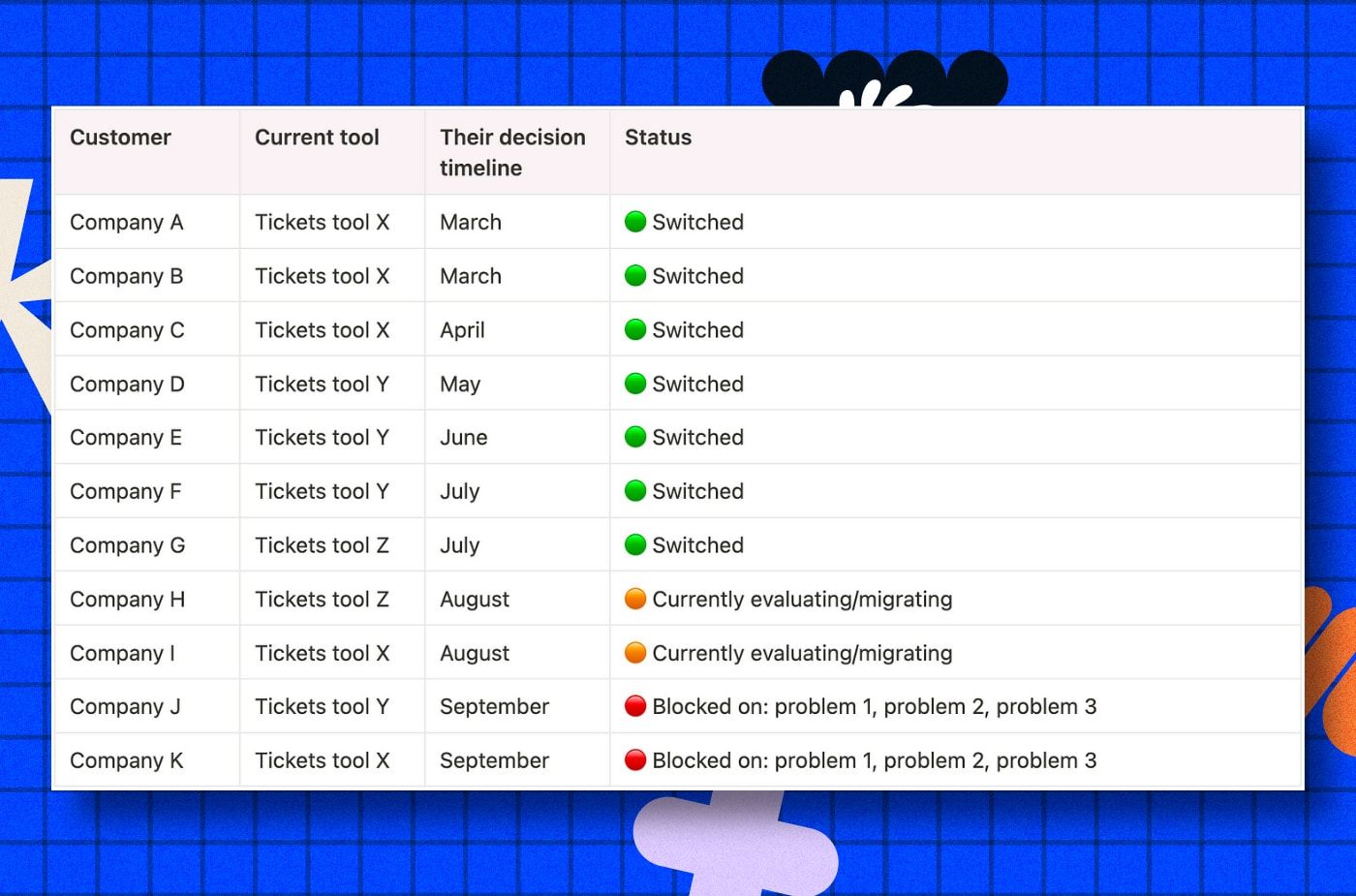
Navigating product-market fit: An inside look at Intercom’s new ‘PMF Panel’
Product-market fit (PMF) is often hailed as the ultimate goal for startups, but it’s equally important for established companies seeking to launch new features or products.
The term product-market fit was popularized by Marc Andreessen, who defined it as “being in a good market with a product that can satisfy that market.” Or as our Chief Product Officer Paul Adams put it, product-market fit “means that your product works for your target market, that it is fit for purpose, that it does the things your customers need it to do.”
It’s very much seen as a critical first step for startups – if they fail to achieve PMF, they fail entirely. However, you don’t just achieve PMF once – even well-established companies have to keep fighting for PMF over and over, as they move upmarket, as technologies evolve, as customer preferences change, and so on.
“We devised a new approach to identifying PMF. Rather than releasing a product or feature and seeing how it performs in the wild, we created the PMF Panel”
So how do you know when you’ve achieved PMF for a given product or feature? Traditionally, startups discover whether they have PMF if they start seeing rapid growth in user adoption or revenue. But for established companies like Intercom that are building complex features for sophisticated users, we needed a better way of gauging PMF.
So we recently devised a new approach to identifying PMF. Rather than releasing a product or feature and seeing how it performs in the wild, we created the “PMF Panel” – a small, representative group of potential customers with specific needs that our product was not yet able to meet.
Missing the mark on Tickets
Where did we need to identify better product-market fit? Well, there was a glaring area where our product was not meeting many of those needs – ticketing. For a long time, our product suite lacked a full-fledged tickets solution. This wasn’t just a missing feature; it was a hindrance that led many customers to use Intercom solely for live chat support. Frequently, customers resorted to other support tools to manage the rest of their customer support processes, preventing us from becoming their primary, all-in-one solution.
“The breadth and depth needed for a holistic support ticketing experience were missing. We didn’t have PMF”
We took a swing at closing the tickets gap in 2022. However, it became evident that while customers were keen to consolidate their support ecosystem within Intercom, our solution simply wasn’t cutting it – as Paul Adams put it, “Tickets was an iceberg type of problem, and we’d only scratched the surface of understanding the complexity.” The breadth and depth needed for a holistic support ticketing experience were missing. We didn’t have PMF.
To right this ship, we heavily invested resources this year, deploying five to six teams solely on this initiative – a significant investment by our standards.
Who are we building for?
We started the year by sharpening who we’re optimizing for and which customers would help us reach product-market fit faster. We identified two primary types:
- Process-oriented customers: They already use dedicated ticketing systems like Zendesk, Freshdesk, or ServiceNow alongside Intercom for live chat. Their demands are stringent, and a switch would only happen if it positively impacts their existing process.
- Ad-hoc customers: This group employs a mishmash of ad-hoc solutions like Slack and Google Sheets for ticketing. They’re dissatisfied with their current process and hence more open to making the switch with flexible requirements.
Our target for validating PMF? The first bucket. We considered it a significant win if we could get these process-oriented customers to switch to Intercom. This is the true test.
Avoiding the metrics trap: why we ditched ‘adoption’
Our initial inclination was to measure PMF through adoption rates. But three issues became apparent:
- Lagging indicator: Adoption rates are reflective of past efforts and don’t offer real-time insights for quick pivots.
- Misleading signals: We could artificially boost adoption by targeting the “Ad-hoc customers,” but that wouldn’t help us gauge genuine PMF.
- Diversion of focus: Focusing on adoption metrics early on might lead us to optimize secondary features like better onboarding, while neglecting the core product capabilities.
Now, you might be wondering, have we completely abandoned the adoption metric? The answer is no. We still track it closely, but it’s not our optimization focus right now. Once we’re confident that we’ve built a ticketing solution that truly fits the market, optimizing for adoption will naturally follow. In short, we’ve sidelined it as a key performance indicator only temporarily, until we’re sure we’re on the right track with the product.
Introducing the PMF Panel
Once we were clear on the type of customers we were targeting, we set about assessing how to ensure we were going to achieve product-market fit this time around. Our revamped strategy involved creating the “PMF Panel” – a carefully selected group of customers from the “process-oriented” category, who were using Intercom for live chat, but relying on alternative tools for their ticketing. Our objective? Get these customers to use Intercom as their single customer service platform.
To keep a pulse on how we were doing with our PMF Panel, we set up a simple but effective table containing:
- Customer: This includes the name of the company and our primary point of contact within that organization. Knowing who to reach out to streamlines communication and ensures we’re talking to the decision-maker or influencer.
- Current tool: Identifying the existing ticketing tool that the customer is using helps us tailor our offering.
- Decision timeline: Often, the customer’s decision to switch is tied to their current tool’s contract end date. Knowing this timeline helps us align our development schedule to make the product compelling enough for the switch to happen seamlessly.
- Status: This is a real-time update on where we stand with each customer. If there is a bottleneck, we make it a point to identify it.

Risks and mitigations
- Overindexing on a few: While a small group can provide deep insights, it’s essential to diversify this group to avoid skewed feedback. In our case, it was critical to ensure we have a diverse representation of company types and industries (B2B as well as B2C, e-commerce, fintech, etc.) on the panel.
- Time-intensive recruitment: Quality over quantity was our mantra. A smaller group of high-quality customers was our starting point, which would gradually be expanded.
Unforeseen benefits of the PMF Panel
Altered roadmap
One of the most illuminating outcomes of our PMF Panel was its impact on our product roadmap. For example, there was a top-requested feature relating to custom ticket states and ticket attributes that, according to its frequency in our general pool of feedback, seemed urgent. However, our PMF Panel made us realize something crucial: while this feature was indeed important to them, it was not a deal-breaker.
Our PMF Panel customers indicated that they would still be willing to make the switch to Intercom even if this particular feature wasn’t immediately available, as long as they knew it was coming down the line. This was a significant insight. It meant that this feature was a “nice-to-have” for the immediate transition, but not a “must-have.”
Contrast this with other features related to back-office tickets, tracker tickets, and side conversations that were flagged by our PMF Panel as being absolutely essential for them to even consider making the switch. These were the non-negotiables, the “must-have” features that needed to be fully ready and operational before they would commit to Intercom.
Team synergy and morale
One of the most heartening changes we observed from this approach was in team dynamics. The focus on the PMF Panel didn’t just align our product roadmap – it also transformed our team into an army of customer success agents.
“It was as if everyone on the team had taken on a second role, that of customer success, in addition to their primary duties”
Engineers, designers, and product managers started going above and beyond to eliminate any barriers faced by our PMF Panel members. Even the most minor issues reported by customers were promptly addressed. This level of commitment was unprecedented.
Team members willingly jumped on calls to help customers with their setup, sent them best practices via email, and initiated rapid fixes for any bugs that were reported. It was as if everyone on the team had taken on a second role, that of customer success, in addition to their primary duties.
The outcome of this energetic focus was a team deeply engaged with the customer experience. They didn’t just understand the customer use cases in theory; they felt them viscerally. This intimate understanding translated into a sense of impact, fortifying the team’s morale and further aligning everyone toward our ultimate goal of achieving product-market fit.
Faster feedback loop
The panel served as an ongoing source of actionable insights. Teams needing feedback could now get it within a day by just referring to the panel, significantly accelerating our development cycle.
In this sense, the PMF Panel functioned as a kind of high-speed, high-quality user research group, helping to steer us in the right direction at each stage. While we hoped to derive this sort of benefit from the panel, in practice it was much more valuable for getting these in-the-moment insights than we anticipated.
The ultimate validation
As we started addressing the concerns and needs of our PMF Panel, something remarkable happened. Not only did we see the panel members gradually making the switch to Intercom, but we also began to notice a similar trend among prospects that were not part of this panel.
It turns out that by refining our Tickets solution based on the feedback of a select, yet diverse, set of customers, we were actually creating a product that had broader appeal. The features and improvements that were “must-haves” for our PMF Panel turned out to be equally enticing for a wider set of customers.
Is the PMF Panel approach repeatable?
Absolutely. Creating the PMF Panel has proved instrumental in helping us validate our approach to achieving product-market fit for our Tickets product. It’s a technique that’s not just applicable to startups but also to any mature product looking to expand or improve.
“Most exciting of all, we’re also applying the PMF Panel approach to the development of entirely new product areas, such as our AI chatbot, Fin”
In fact, it has proven so successful that we have adopted it across our R&D teams, and we’re learning just how flexible it can be. We’re using it as we make improvements in our established product areas, such as our Articles help center product, as well as develop features that Intercom has not previously had, such as integrated phone support, providing a solution to a problem that our customers have had to use other tools to solve. Most exciting of all, we’re also applying the PMF Panel approach to the development of entirely new product areas, such as our AI chatbot, Fin. The PMF Panel is proving extremely valuable in all these cases.
If you’re in the B2B SaaS space and striving to find your product-market fit, this approach is highly likely to achieve PMF faster than most other approaches.
Ultimately, building products that look attractive to potential customers is one thing, but actually delivering enough value to win them over is another thing entirely. Figuring out how to do that repeatedly is the key to long-term product-market fit for companies of all sizes.
For more of Nadine’s essays about product management, check out her Substack here







